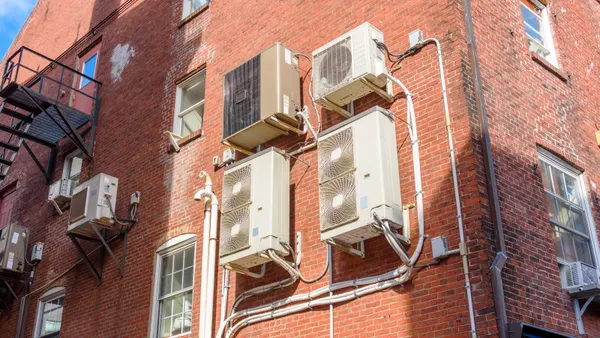Dive Brief:
- California regulators have outlined their strategy for transitioning from fossil fuels towards cleaner generation to power communities during wildfire-related public safety power shut-offs for the 2021 wildfire season and beyond.
- In a proposal issued Monday, regulators recommended that utilities file applications with the California Public Utilities Commission (CPUC) by June 30, 2021, detailing their plans for switching to clean resources for future shut-offs, as well as how they intend to procure them.
- The CPUC's plan is part of a sweeping proposed decision that would implement new microgrid-related rates, tariffs and rules for utilities. The earliest that regulators can vote on the proposal is Jan. 14.
Dive Insight:
California utilities deploy public safety power shut-offs during times of high wildfire risk, in an attempt to prevent their fire lines from sparking a fire. The shut-offs can last days and the CPUC has allowed utilities to procure temporary generation — including diesel generators — to minimize their impacts, an issue that has concerned some environmental advocates.
In June, PG&E said in comments filed with the agency that it could need to use diesel and natural gas generators during these shut-offs beyond 2020, due to the lack of alternatives for reliable, long-duration mobile generation at the required scale.
Under Monday's proposed plan, the commission would still allow a utility to use diesel and other temporary generation during PSPS events in 2021, but with several conditions, including the requirement that any previous such programs have proven effective at serving load.
However, regulators expect the utilities to "minimize" their use of diesel given its air pollution impacts, encouraging them to use options like hydrotreated vegetable oil where possible instead. Utilities would also be required to brief the commission early next year on the total number of diesel generators it used, as well as where and when they were deployed.
At the same time, the CPUC wants utilities who are turning to these resources to also document their plans for creating "clean" microgrids at substations. Proposed solutions would need to significantly reduce emissions from substation islanding by the 2022 fire season, with a $350 million cap on the total cost of all the projects.
On a longer-term basis, utilities would also need to file applications by June of next year demonstrating their broader plan to transition to clean generation during PSPS events, including identifying areas that could experience these shut-offs for more than three years.
Utilities have held solicitations over the last couple of years to consider private solutions to some of these challenges, Mark Feasel, president of the smart grid arm of Schneider Electric, said — but they faced their own challenges, like short windows to submit applications and stringent return-on-investment requirements.
"The technology exists today to use renewable energy, solar-plus-storage … to create a scenario in which we're providing power locally such that distribution feeders could be taken down in order to eliminate the possibility of wildfires," Feasel said, adding, "But the business model angle is still lacking — [there aren't] really the kind of incentives to allow this to proliferate."
Without this framework, he said, "we end up with 1970s solutions to 2020s problems."
PG&E is still reviewing the proposed decision, but is committed to moving towards a cleaner generation portfolio for public safety power shut-offs, utility spokesperson Paul Doherty said in an email. The utility also recognizes that renewable diesel and natural gas mobile temporary generation technologies will be part of the solutions in 2021, while newer technologies move through the testing and demonstration phases, he added.
"Just as California's successful campaign to power the grid with cleaner energy resources did not and could not occur in a year, we cannot expect a transformation in mobile generation to occur in a similar timeframe," Doherty said.
CPUC proposes microgid rule changes, tariffs, incentive program
The CPUC's proposal also includes policies to promote the deployment of microgrids, among them having utilities modify rules to allow microgrids to serve two adjacent premises during an outage. In addition, PG&E, Southern California Edison and San Diego Gas & Electric would need to create a new microgrid tariff for their service territories, as well as an incentive program.
But while the proposal addresses utility-owned front-of-the-meter microgrids, it does not include behind-the-meter systems that might be owned by consumers or private capital, Feasel said. Policies targeting behind-the-meter microgrids could include easing interconnection requirements, or considering how microgrids can be monetized.
"The ability to harness the power of these behind-the-meter solutions is important, and it represents a real way that problems can be solved," but mechanisms to incentivize that behavior don't exist, Feasel said.
The Microgrid Resources Coalition, which comprises owners, developers, investors and other players in the microgrid industry, expressed frustration with the proposed decision. Allie Detrio, senior advisor with the coalition, said in an email that the proposal opted to authorize nearly half a billion dollars in ratepayer funding for utility microgrids over creating a robust customer microgrid tariff.
"Given California's challenges with utility rate hikes and energy affordability, this was a missed opportunity by the CPUC to leverage private sector investment and capital to build resilient energy resources like microgrids across the state without using substantial ratepayer funds," Detrio added.














